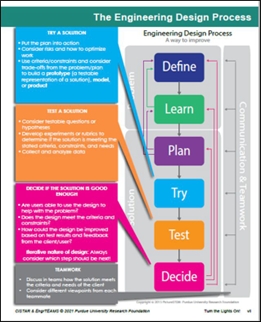Nine-Session Unit Exposes Middle School Students to Complete Engineering-Design Process
Outcome/Accomplishment
Incorporating a design challenge, a nine-session unit teaches eighth-grade students mathematical and scientific concepts related to electrical energy and renewable resources in lessons developed at the Center for Innovative and Strategic Transformation of Alkane Resources (CISTAR), an NSF-funded Engineering Research Center (ERC) based at Purdue University.
Impact/Benefits
The lessons expose students to the complete engineering-design process, including problem scoping, solution generation, redesign, and communicating the final design to a client. Students learn about maintaining an engineering design notebook, teamwork, communication, data analysis, and iteration.
Explanation/Background
Videos explaining the curricula and step-by-step instructions for implementation are available on the nanoHUBwebsite and on Teachers Pay Teachers. Also, curriculum kits with the required materials for implementing the activities can be checked out.
Location
West Lafayette, Indianawebsite
Start Year
Energy and Sustainability
Energy, Sustainability, and Infrastructure
Lead Institution
Core Partners
Fact Sheet
Outcome/Accomplishment
Incorporating a design challenge, a nine-session unit teaches eighth-grade students mathematical and scientific concepts related to electrical energy and renewable resources in lessons developed at the Center for Innovative and Strategic Transformation of Alkane Resources (CISTAR), an NSF-funded Engineering Research Center (ERC) based at Purdue University.
Location
West Lafayette, Indianawebsite
Start Year
Energy and Sustainability
Energy, Sustainability, and Infrastructure
Lead Institution
Core Partners
Fact Sheet
Impact/benefits
The lessons expose students to the complete engineering-design process, including problem scoping, solution generation, redesign, and communicating the final design to a client. Students learn about maintaining an engineering design notebook, teamwork, communication, data analysis, and iteration.
Explanation/Background
Videos explaining the curricula and step-by-step instructions for implementation are available on the nanoHUBwebsite and on Teachers Pay Teachers. Also, curriculum kits with the required materials for implementing the activities can be checked out.

